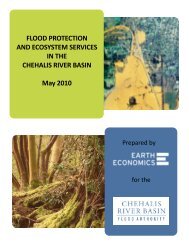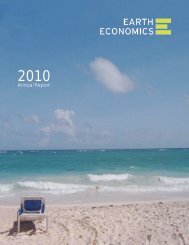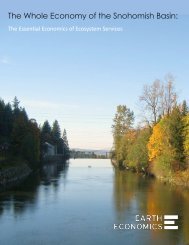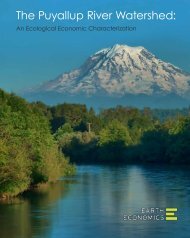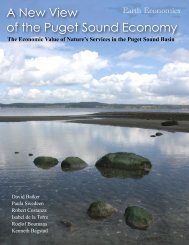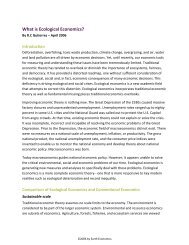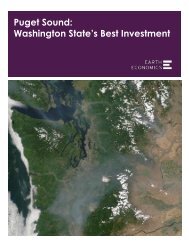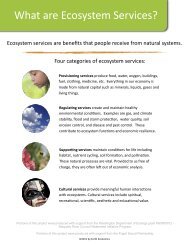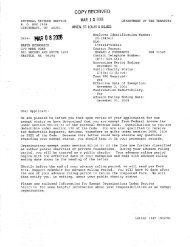The Spot Prawn Fishery: A Status Report - Earth Economics
The Spot Prawn Fishery: A Status Report - Earth Economics
The Spot Prawn Fishery: A Status Report - Earth Economics
Create successful ePaper yourself
Turn your PDF publications into a flip-book with our unique Google optimized e-Paper software.
<strong>The</strong> <strong>Spot</strong> <strong>Prawn</strong> <strong>Fishery</strong>: A <strong>Status</strong> <strong>Report</strong><br />
trawlers fish single-day trips and have developed<br />
methods to keep prawns cold and alive<br />
without elaborate refrigeration systems.<br />
In 1997 spot prawns commanded an average exvessel<br />
price of $16.50 per kilogram ($7.50/lb.). In<br />
1999, the ex-vessel price for live product ranged<br />
from $3.50 to $10.60/kg. <strong>The</strong> estimated total value<br />
of the fishery to the State was approximately US<br />
$4.3 million in 1999. In that year, the fishery was<br />
ranked 32nd among California’s commercial fisheries<br />
in terms of total volume. It ranked eighth in<br />
total value, based on ex-vessel prices and ex-vessel<br />
price per pound, coming in second, behind lobster.<br />
<strong>The</strong> fishery was 3.0% of the 1999 value of<br />
California’s commercial fisheries. Currently, the<br />
price for live prawns is between $8 and $11 per<br />
pound dockside. Dead prawns are valued at<br />
between $3 and $4 per pound (National<br />
Fisherman 2001).<br />
Existing Management and<br />
Regulatory Systems<br />
<strong>The</strong> spot prawn fishery in California is managed<br />
through a series of regulations that have become<br />
more restrictive in recent years (Reilly, CDFG. Pers.<br />
comm., March 2001). Since stock assessments are<br />
unavailable for the spot prawn resource, management<br />
and regulatory systems have primarily been<br />
developed in response to the examination of<br />
trends in landings and CPUE data. Consultations<br />
with fishers and the fishing community have also<br />
informed and directed the development of the<br />
existing management regime.<br />
Summary of Trawl Regulations<br />
•Trawlers are required to purchase a $30 shrimp<br />
and prawn trawl permit. Not more than one permit<br />
shall be issued to any one person.<br />
•A statewide seasonal closure from November 1<br />
through January 31 is in effect in order to protect<br />
egg-bearing females.<br />
•Trawling is prohibited within three miles of the<br />
shore (both the mainland and islands), and in<br />
waters less than 25 fathoms deep. Trawling is<br />
also prohibited in Santa Monica Bay.<br />
•Trawl nets with single-walled cod ends are<br />
required to have a minimum mesh size of 1.5 in.<br />
and a functional finfish excluder with a minimum<br />
surface area of 36 in. Finfish excluders are<br />
required to minimize bycatch, particularly of<br />
species of concern, such as rockfishes. <strong>The</strong> minimum<br />
mesh size for double-walled cod ends is<br />
3 in.; these are not required to have bycatchexcluder<br />
devices.<br />
•Incidental catch restrictions are in place for all<br />
fish, particularly federally managed groundfish<br />
species. Not more than 1,000 pounds of any incidentally<br />
caught fish may be retained. During the<br />
seasonal closure for spot prawns, hauls may not<br />
contain more than 50 pounds, or 15% spot<br />
prawns by weight.<br />
Summary of Trap Regulations<br />
•Trap vessels are required to carry a $35 general<br />
trap permit.<br />
•Trap vessels are not subject to any area closures.<br />
In practice, trap fishing is limited to available<br />
spot prawn habitat that does not overlap with<br />
trawlable waters.<br />
•<strong>The</strong> trap fishery is closed from November 1<br />
through January 31 south of Point Arguello, and<br />
from May 1 to July 31 north of Point Arguello, in<br />
order to protect egg-bearing females.<br />
•Traps are required to have a minimum mesh<br />
size that is no less than 7/8 in. by 7/8 in., such<br />
that a 7/8-in.-square peg can fit through the<br />
mesh without stretching it. <strong>The</strong> regulations provide<br />
for only plastic or wire mesh; nonetheless,<br />
some fishers use monofilament.<br />
•All traps must have at least one destruct device<br />
in order to create an escape opening of at least 5<br />
in. diameter in the top or upper half of the trap<br />
when the device material corrodes or fails.<br />
•Each vessel is limited to 500 traps, except within<br />
three miles north of Point Arguello, where only<br />
300 traps are allowed.<br />
Management Issues and Concerns<br />
Management Recommendations<br />
<strong>The</strong> capitalization and effort in California’s spot<br />
prawn fishery have increased rapidly in the last<br />
10 years. <strong>The</strong> increasing market demand for<br />
prawns, in combination with a growing number<br />
of displaced fishers due to the overfishing and<br />
collapse of other fisheries, guarantees that this<br />
growth will not taper off in the near future. To<br />
ensure long-term sustainability, management<br />
recommends the following measures:<br />
42



